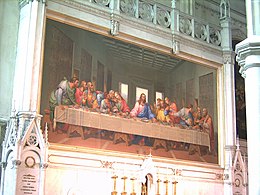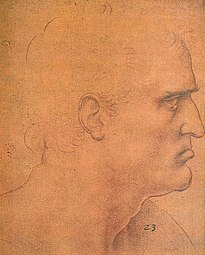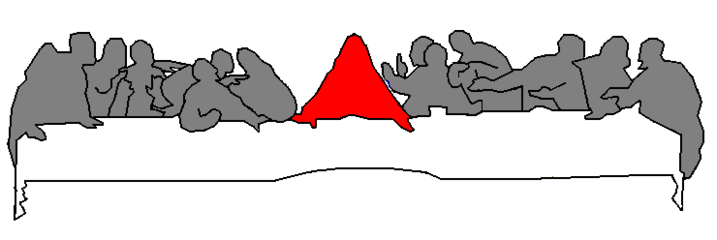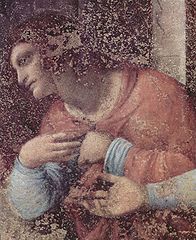The Last Supper (Leonardo da Vinci)
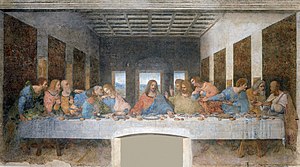
|
| The Lord's Supper |
|---|
| Leonardo da Vinci , 1494-1498 |
| Secco |
| 422 × 904 cm |
| Santa Maria delle Grazie |
The Last Supper (Italian: Il Cenacolo or L'Ultima Cena ) by the Italian painter Leonardo da Vinci is one of the most famous wall paintings in the world.
The work carried out in Secco technology was created in the years 1494 to 1497 on behalf of Duke Ludovico Sforza of Milan . It decorates the north wall of the refectory (dining room) of the Dominican monastery of Santa Maria delle Grazie in Milan and is considered the highlight of Leonardo's painterly work.
General
The picture measures 422 cm × 904 cm and shows Jesus with the twelve apostles immediately after he said to them at the last meal together on the eve of his crucifixion : "One of you will betray me" ( Mt 26,21 EU ).
This theme has been portrayed very often in art. Leonardo knew from Florence the fresco The Last Supper by Domenico Ghirlandaio , which is regarded as a direct precursor. Leonardo's picture is considered a milestone of the Renaissance , because it had a groundbreaking influence on the painting of the West because of its correctly reproduced perspective depth.
The table and the apostles are placed on the front edge of the room where the meal takes place. The space behind it narrows, and the people depicted seem to be looking into the space of the refectory. However, the light that illuminates the scene does not come from the three-part painted window, but at an angle from the left like the real light that comes in through the window on the left wall. In this picture you can find the golden ratio in many places , for example where the hands of Jesus and James the Elder (to the right of Jesus) are on the table, the picture is divided in this ratio.
For conservation reasons, a visit is only possible in small groups of a maximum of 25 participants for 15 minutes each. The booking of admission tickets for fixed dates (time slot tickets) is mandatory and must be registered at least one week before the visit in order to avoid waiting times.
history

After Leonardo had finished working on the clay model of the Sforza monument, he began - also on behalf of Duke Ludovico Sforza - the Last Supper in the refectory of the Santa Maria delle Grazie monastery in 1495 . He had already sketched out his first ideas on a study for an Adoration of the Magi , which shows a group of men from the entourage of the kings on a board.
In a red chalk drawing , he arranged the disciples in groups of two and showed references to the representations of the Last Supper by Domenico Ghirlandaios and Andrea del Castagnos . John is also resting with his upper body on the table to the left of Christ and Judas is sitting in front of the table, isolated from the other apostles. In a note, Leonardo described the different attitudes of the disciples:
“Someone who was about to drink, but left the mug in its place and turned his head to the narrator. Another, crossing the fingers of his hands and frowning, turns to his neighbor. Another, with his hands open, shows his palms, lifts his shoulders against his ears and opens his mouth in astonishment. Another says something in the ear of his neighbor, and the one who listens turns to him and listens to him, a knife in one hand and the bread cut with this knife in the other. Another, with a knife in his hand, overturns a mug on the table with that hand. Another puts his hands on the table and stares straight ahead. Another blows on his bite. Another leans forward to see the narrator and shadows his eyes with his hand. Another steps back behind the one leaning forward and looks between the wall and the person leaning forward at the narrator. "
In careful individual studies that are now in Windsor Castle , Leonardo prepared the heads of the apostles and looked for a suitable model for Jesus. The poet Matteo Bandello , whose uncle was the prior of the monastery, often observed Leonardo painting the Lord's Supper and reported the following about it:
“He often came to the convent early at dawn and I could see him at work. He hurriedly climbed up on the scaffolding, worked diligently until the shadows of the evening forced him to quit, and never thought of eating, he was so absorbed in his work. At other times he would come for three or four days without touching his picture and stand in front of it for only a few hours with his arms crossed, looking at his characters as if criticizing them himself. I also saw him often at noon, without looking for shade, hurrying to the convent on the fastest route when the glow of the sun at its zenith had made all the streets of Milan deserted. He came from the citadel where he modeled his colossal horse [the Sforza equestrian statue]. In the convent he applied a brushstroke or two and then went back immediately. "
Vasari tells the following anecdote about the prior's impatience :
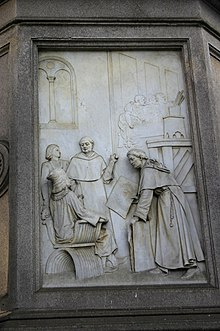
“It is said that the prior of the monastery urged Leonardo very impetuously to finish the work: it seemed strange to him to see Leonardo lost sometimes half a day in thought; He would have preferred if he, like workers who chop the garden, had never put the brush down. Since he was not being served, he complained to the duke and urged him until the latter was compelled to have Leonardo summoned and moved him to work in a friendly manner, assuring him that he was only doing this at the urgency of the prior down.
Leonardo knew the prince's clear mind and tact, and so he decided to discuss the matter with him at length, which he had never done with the prior. He spoke extensively on art and made it clear that sublime spirits sometimes create the most when they work the least, namely when they invent and develop perfect ideas which the hands express and represent according to those already conceived in the spirit. Two heads, he added, were still missing, that of Christ, whom he did not want to search for on earth, and from whom he did not believe that his imagination could have that beauty and heavenly grace which the Incarnate had in mind Deity befitting; the other is that of Judas, on whom he ponders. It seemed impossible to him to invent suitable facial features for one whose defiant spirit, after so much received benefits, would have been able to resolve to betray his Master, the Savior of the world; but he would look for the latter, and if he could not find anything better, he would certainly remain that of the annoying and tactless prior.
This made the Duke laugh a lot and he agreed with Leonardo a thousand times. The poor prior, confused, tried to do the work in the garden, but he left Leonardo in peace; this brought Judas' head to an end so perfectly that it is the true picture of betrayal and inhumanity; the head of Christ, however, remained unfinished. "
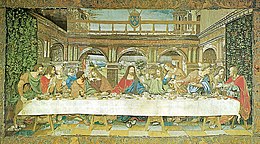
In the execution, Leonardo tried to use the oil technique for wall painting . Due to the dampness of the wall and the use of experimental organic colors, which soon proved to be a mistake, the painting suffered severe damage from fine cracks while Leonardo's lifetime. Over time, the paint also peeled off over large areas. Jesus' feet, which Leonardo had originally depicted, fell victim to a door that was later drawn into the wall.
The French King Francis I was so impressed by the picture that he wanted to have it removed from the wall and take it to France. However, according to Giorgio Vasari , the associated difficulties "resulted in His Majesty losing interest and it [the picture] remained with the Milanese". During the next twenty or thirty years numerous copies were made in Italy and Flanders, some of which have survived and give an impression of what the Lord's Supper may have originally looked like. When the Dauphin of France, who would later become Henry II , married Caterina de 'Medici in 1533 , King Francis I sent a large tapestry with a copy of Leonardo's Last Supper , which can be seen today in the Vatican. The tapestry is richly decorated and shows in the background a complicated architecture in the Italian style, as was common in France at the time.
Napoleon's occupation forces then turned the refectory into a horse stable. Napoléon did give, but this was not completed until after his fall and his father a mosaic copy commissioned I. Emperor Franz was purchased. It turned out to be too big for its originally intended place of installation in the Belvedere , so that it ended up in the Minoritenkirche in Vienna .
In 1943, Leonardo's painting survived an air raid that brought down the south wall of the refectory in Milan. The Lord's Supper remained intact as it had been protected with sandbags by the brothers of the monastery.
Restorations
The Last Supper was restored several times, notably by Bellotti (1726), Mazza (1770) and Berezzi (1819). It was not until the 20th century that modern techniques were used to halt the decay of the image. The restorer Giuseppina (called Pinin) Barcilon Brambilla worked on the restoration for twenty years until it was completed in 1999, supported and critically accompanied by the Milanese soprintendent Carlo Bertelli and the art historian Renzo Zorzi. The art historian James Beck made negative comments without having seen the restoration, and the art historian Cesare Brandi , regarded as an authority in Italy, was initially one of many skeptics and opponents of the restoration, but then abandoned the restoration after a visit to the construction site Convince Brambilla's work.
Today the Lord's Supper can be viewed again, but is protected by security and dust locks. Only about 100 visitors are admitted per hour, admission is only allowed for a limited time (15 minutes) and only after prior appointment by telephone (one week in advance at the latest).
In 1980 the church was declared a World Heritage Site by UNESCO, together with the painting .
Portrayed
Leonardo's composition of this traditional ecclesiastical theme is livelier / more agitated than previous works. He dispenses with halos and the pictorial isolation of the traitor Judas. He groups the apostles into four sub-units, who react in different ways to his revelation “One of you will betray me”.
Bartholomäus, Jakobus the Younger and Andreas
Bartholomäus, Jakobus the Younger and Andreas form a group of three on the left edge, which expresses the surprise of the moment.
- Bartholomäus (probably identical with " Nathanael " from the Gospel of John) - blue robe (far left). According to legend, he preached in India, Mesopotamia and Armenia, where he is also said to have suffered martyrdom. Astyages is said to have given the order to peel off his skin while he was alive and then to crucify him upside down. Bartholomew leans on the table and is indignant.
- James, the son of Alphaeus , brother of Thaddäus, also “James the Younger” - red robe (2nd from left). In church history, James, the son of Alphaeus, was also equated with James the Little and with James, the brother of Jesus. James the Little is mentioned only once in the Bible (Mt 27:56), as the son of a disciple of Jesus named Mary and brother of a Joses. Jacobus seems to remain calm, but he is rigid with shock.
- Andreas, brother of Simon Peter - yellow robe (3rd from left). Andrew was first a disciple of John the Baptist, who then referred him to Jesus, whereupon he also led his brother Simon to Jesus with the message "We have found the Messiah" (Jn 1,35-42). Hence his traditional nickname of the first appointed. In the apostellists, Andrew always appears among the first four apostles. Andreas pulls his shoulders up in this picture and fends off with his hands that say: "But not me!"
- Bartholomäus, Jakobus the Younger and Andreas
Judas, Peter and John
Peter bends down to Jesus' favorite disciple, John, who bows his head, while the traitor Judas turns away from both of them in a distant manner.
- Judas Iscariot sits in partial shade - recognizable by the money bag. Perhaps the indicated rotation expresses distancing. According to all four Gospels, he is said to have enabled Jesus to be arrested in Jerusalem in the garden of Gethsemane by the leading groups in the Sanhedrin, with the result that Jesus was handed over to the Romans and crucified by them. The early Christians therefore regarded him as the one who betrayed Jesus (Mk 3.19 EU). In contrast to conventional depictions, Judas sits on the same side of the table as the other disciples. While the disciples discuss in dismay, he remains motionless. Judas is placed between the quick-tempered Peter and the gentle John. His gaze goes over the head of Jesus. The Austrian writer Leo Perutz wrote the novel “Der Judas des Leonardo” (posthumously, 1959) about the model for Judas : Leonardo da Vinci would like to finish his painting after fourteen years, but he lacks the model for the head of Judas because he is looking for "the very worst person in all of Milan". He finally finds the Bohemian merchant Joachim Behaim, who returns to Milan after eight years and is surprised that people are gossiping about him until he looks at the Lord's Supper and realizes that Judas has his face.
- Simon Peter (4th from left; speaks to John). According to all the gospels, his name was Simon. Paul of Tarsus, on the other hand, always called him Cephas without a first name. This expression is a Graecization of the Aramaic word kefa כיפא, translated into Greek πετρος (petros) , Latinized Peter. It usually means "stone" in both languages. Jesus is said to have given Simon this nickname personally; where and when he did this, the Gospels deliver differently. Mt 16,18 EU explains the epithet with Jesus' promise to Peter: “I want to build my church on this rock.” Peter is eager to find out who the traitor will be.
- John (6th from left) sits on Jesus' right side. In the church tradition, John is identified with the “favorite disciple” of Jesus from the Gospel of John. He was the only disciple under the cross. John is at peace with himself because he knows that no one will suspect him. So he sits quietly and mourns what has happened. However, there are also interpretations that say that the portrayal of John is Mary Magdalene . This interpretation is based on the argument that you can see the base of the breast if you enlarge the picture.
- Judas, Peter and John
Jesus
Jesus (with a red robe and a blue robe) seems to be looking in the direction of his upturned left palm. The right hand is on the table. The central perspective and the incidence of light clearly emphasize the importance of Jesus.
- Jesus
Thomas, James the Elder and Philip
Thomas, James the Elder, and Philip express more anger and questions. James spreads his arms and thereby forms a barrier that prevents the questioning gestures of Thomas (with raised index finger) and Philip (both hands pointing to his chest).
- Thomas , also "Didymos Judas Thomas". The name Thomas comes from Aramaic and means "twin". That is why Thomas is also called "Didymus" (Greek didymos, δίδυμος) in the Bible. According to tradition, he is the "unbelieving Thomas" because he initially doubted the resurrection of Jesus until he was allowed to see and touch the wounds of the risen Christ himself. Thomas points to heaven as if to say: "Woe to the traitor!"
- James, the son of Zebedee, or James the Elder (sitting directly on his left side when viewed from Jesus). He is said to have been the apostle who preached on the Iberian Peninsula after the ascension of Jesus. He spreads his arms and thereby forms a barrier to Jesus.
- Philip - red robe (4th from right, just jumped up). Philip was called directly by Jesus to follow him (John 1:43). It is he who passed on what he had experienced to Nathanael. Philip is deeply concerned and cannot believe that the prophecy is really happening.
- Thomas, James the Elder and Philip
Matthew, Thaddäus and Simon Zealotes
Matthew and Thaddäus turn questioningly to Simon from Canaan, who is sitting on the far right. They debate the revelation of Jesus, their gestures adding to the shock.
- Matthew, the (former) tax farmer and later evangelist (identity with the evangelist Matthew cannot be proven) - (3rd from right). According to ancient church tradition, Matthew is said to have been the first to write his Gospel in Hebrew. In his catalog of church writers, Hieronymus (347–419 AD) says: “Matthew, who is also Levi and who went from a tax collector to an apostle, and as the first of all evangelists, wrote a gospel of Christ in Judea in in the Hebrew language and in Hebrew characters for the benefit of those from the circumcision who believed ”… Matthew asks Simon:“ Can it be true what Jesus just told us? ”
- Thaddäus, his brother , also Judas Thaddäus - (2nd from right). According to the sources, the person Thaddäus cannot be clearly identified in the circle of twelve and has given rise to speculation. He is also identified with Simon Zelotes. As church patrons, both often appear together as "Saint Simon and Jude". Squidward can't believe his ears and asks Simon what the prophecy is all about.
- Simon Zelotes Canaanäus - white robe (far right). His nickname Zelotes, in Aramaic “Kananäu”, in German “der Eiferer”, he received probably due to his original membership of the radical Zealot party, which set itself the goal of forcibly expelling the Romans from Israel. In the New Testament of the Bible only his name and surname appear, and that only in the Apostellists; other details about him are completely missing. According to tradition, after the crucifixion of Christ, Simon preached the gospel in Babylonia and Persia, where he is said to have been martyred with Judas Thaddäus. Simon tries to understand the incomprehensible.
- Matthew, Thaddäus and Simon Zealotes
The perspective
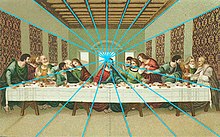
Leonardo da Vinci commented on perspective as follows in Codex Madrid :
“[…] An eye looking at a wall painting always moves to the center of the picture. In itself, the perspective offered by a straight wall is wrong if it does not correct the position of the viewing eye by showing the wall in a shortened perspective. "
In the history of perspective modes of representation, the leap from the use of craft rules and experience to the application of mathematically founded construction systems took place in the 15th century - Leonardo's Last Supper is the prime example.
Leonardo himself writes about the perspective of the Lord's Supper:
“When you stand very close to the figure of Christ before the Lord's Supper, the side parts inevitably appear smaller in relation to the center of the fresco, which is closer to you. If, as we have seen, the traditional - flat - perspective shows the outermost sides of the picture unduly enlarged, they are reduced by the eye of the beholder once it is in the central axis; And it is easy to show that these two distortions cancel each other out, assuming the viewer is exactly at the top of the viewing pyramid, the intersection of which the painting is supposed to form, which corresponds to the third of the above requirements. In all other cases it happens that the distortions of the flat perspective and the distortions which the spherical, (Leonardo's) natural perspective imposes on the perceived painted surface, add up or overlay one another instead of canceling out one another; and the picture thus appears monstrous. "
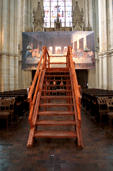
The perspective used in the Lord's Supper is a central perspective as it is still used today. As the name suggests, this type of representation of a three-dimensional world on a surface is defined by the presence of a projection center, also called an eye point. The eye point is the viewer's point of view. This eye point is verifiably located in the temple of the Christ figure during the Last Supper (this was determined during the last restoration work - a hole in a nail was found), i.e. the center of the picture determined by Leonardo da Vinci is the temple of the Christ figure and at the same time the point where all the (perspective) rays meet. Da Vinci determined the rays by means of a nail and stretched cords. Ladwein formulates the thesis that the overall composition of the picture with the lines of the central axis suggests a cross-shaped halo around the head of Jesus.
In 2006, on the occasion of an exhibition in the Minorite Church in Vienna, there was an “experimental setup” on the perspective of the Last Supper . This should demonstrate in a spectacular way that the perspective of the Lord's Supper is a central perspective in which the eye point is at the level of the temple of the Christ figure. A staircase was set up in front of the hanging copy of the painting so that this point of view could be taken at eye level. The optimal distance between the viewer and the picture was previously calculated by David Sayn using a computer model.
reception
While the central figure of Jesus was never questioned, the depiction of the disciples did not always find admiration. In 1916, the art historian Bernard Berenson was indignant :
But what a bunch of excited, gesticulating, cheeky people whose faces are anything but pleasant. (...) They are not good company for me!
The painting in modern art

Andy Warhol's last large-format work was supposed to be the examination of Leonardo da Vinci's Last Supper. The painting was created for the newly built exhibition space of the Credito Valtellinese bank, directly opposite the home of the original Last Supper in the Dominican church of Santa Maria delle Grazie in Milan. The bank - the palace and temple of capital - is cleverly combined with the religious icon and at the same time counteracts it. Warhol, however, neutralized the ennoblement of capital inherent in the commission. He did not make himself a disgraceful supplier of decor. Instead of looking at the original, he used the photo as a basis for a cheap reproduction of the original painting by Leonardo, which he found in a junk shop in Little Italy along with a plaster sculpture . This resulted in a huge cycle of paintings, over 100 mostly traditionally painted pictures with a brush, some over 4 × 10 meters in size. However, he did not select the hand-painted works for the exhibition, but rather a total of 22 screen-printed versions.
The original size copy in Haigerloch (Germany)
There is a replica of the picture in the Evangelical Last Supper Church in Haigerloch . The work is executed as a mural in its original size. It was created in 1952/53 in a period of about 22 months by the Düsseldorf painter Friedrich Schüz, supported by the Tübingen graphic artist Gerhard Halbritter and the painter Walter Kröll from Giessen. It was opened to the public on Maundy Thursday 1954.
Imitations and alienations in advertising and art
Due to its high level of awareness, there are numerous parodies and alienations of the Lord's Supper :
art
- Salvador Dalí adapted the picture in 1955.
- Yo Mama's Last Supper by American photographer Renée Cox was exhibited in 2001 as part of an exhibition by 94 "Black Photographers" in the Brooklyn Museum and sparked a lively argument with former New York Mayor Rudolph Giuliani . In this picture Jesus is female and naked.
Movie
- In his film Viridiana (1961) Luis Buñuel arranged the scene of a feast based on Leonardo's Last Supper.
- In Robert Altman's film comedy M * A * S * H (1970), the composition of the image of the Last Supper is modeled on a scene in which the hospital dentist (called: the painless drill ) celebrates his departure before he wants to commit suicide for reasons of sexual inadequacy . He himself takes on the role of Jesus, while his colleagues take the poses of the disciples.
- In the episode film Mel Brooks - The Crazy History of the World (1981), the temporary waiter Comicus ( Mel Brooks ) serves Jesus and the disciples. Leonardo da Vinci is asked to make a group portrait and rearranges the table arrangement as shown in his picture. Comicus stands behind Jesus with a silver tray that parodies the halo .
- In the film Biker Boyz (2003) the painting shows the members of the club.
- In the 2017 feature film Murder on the Orient Express (original title: Murder on the Orient Express), the final scene is optically very much based on the Last Supper painting by Leonardo da Vinci. Director Kenneth Branagh expressly stated this reference to the painting as intended by him.
Fashion, advertising, record sleeves
- In 1993, an advertising motif for the Otto Kern fashion brand appeared , which Leonardo's Last Supper used for advertising purposes and sparked controversy in Germany: instead of the disciples, bare-breasted models sat around a Jesus actor. The poster was reprimanded by the German advertising council and had to be withdrawn. The later motif, in which twelve men were formed around a Jesus actress, was largely ignored.
- The French fashion house Girbaud advertised in France at the end of April 2005 with an ad that only cited the Lord's Supper in formal terms. Twelve female mannequins were on display, one of which clearly represented Christ. Two others hugged a shirtless man in jeans. The Catholic Church filed a lawsuit over blasphemy . On March 10, Judge Jean-Claude Magendie upheld this and ordered Girbaud, on threat of a fine, to have the posters removed throughout France within three days.
- A French advertisement for the VW Golf showed disciples behind a long table, in poses reminiscent of the characters in da Vinci's Last Supper , under the motto “Let's look forward to it, friends, because the new Volkswagen is born” .
- In the advertising campaign for the US series Battlestar Galactica , the fourth season (2008-2009) is advertised with an image in which the actors recreate the painting.
- The CD cover picture of the Steel Panther album All You Can Eat from 2014 shows the band members with women at and on the table.
literature
- Georg Eichholz : Leonardo da Vinci's Last Supper: A systematic picture monograph. scaneg, Munich 1998, ISBN 978-3-89235-222-8 .
- Georg Eichholz: Tema con variazioni: Letters about Leonardo's Milanese Last Supper. scaneg, Munich 2009, ISBN 978-3-89235-122-1 .
- Willi Finkenrath: The testimony of the word: The Last Supper of Lionardo da Vinci. edition lionardo, Wuppertal 2003, ISBN 3-9808672-9-3 .
- Michael Ladwein: Leonardo. The Lord's Supper. World drama and act of redemption. Pforte Verlag, Dornach 2004, ISBN 3-85636-153-7 .
- Leonhard Salleck: The key: Secret messages in Leonardo da Vinci's Last Supper. Kastner, Wolnzach 2004, ISBN 3-937082-11-5 .
- Leo Steinberg : Leonardo's Incessant Last Supper. Zone Books, New York 2001, ISBN 978-1-890951-18-4 .
- Christoph Wetzel : Reclam's book of art. Philipp Reclam jun., Stuttgart 2001, ISBN 3-15-010476-9 .
- Manfred Wundram : The most famous paintings in the world. Imprimatur Druck- und Verlagsgesellschaft, Bergisch Gladbach 1976.
Fiction
- Leo Perutz : The Judas of Leonardo. Deutscher Taschenbuch Verlag, Munich 2005, ISBN 3-423-13304-X .
- Javier Sierra : The Secret Supper. Novel . Limes, Munich 2006, ISBN 978-3-809-02526-9 .
Movie
- The secret of the last supper. (OT: The search for the Last Supper. ) Documentary, Great Britain, 2017, 42:36 min., Book and moderation: Jean-Pierre Isbouts, camera: Aj Martinson, production: Pantheon Studios, German first broadcast: April 18, 2019 at German wave , row: DOKfilm , online video and Summary ( Memento of 26 April 2019 Internet Archive ) of German shaft; English version. - The search for the Last Supper in the Internet Movie Database .
radio
- Tongerlo Abbey probably has real work by Leonardo da Vinci. Radio report, Belgium, 2019, 4:07 min., Script: Kay Wagner, production: BRF , Internet publication : May 2, 2019, manuscript and audio file.
Web links
- Leonardo da Vinci - The Last Supper (zoomable, 16 gigapixels, after free registration)
- Short Video Guide to the painting at artinspector (Engl.)
- Leonardo da Vinci - pictures and drawings
- Viewing the painting (Italian, English)
- The restoration of the painting. In: das-lieter-abendmahl.de
- Facial expressions and gestures of the twelve apostles. In: das-lieter-abendmahl.de
- The Last Supper (Leonardo da Vinci) at Zeno.org .
Individual evidence
- ↑ 460 × 880 cm after Frank Zöllner
- ↑ a b Hans-Joachim Müller : "Last Supper", Leonardo's great promise of art. In: Die Welt , April 17, 2014.
- ↑ Pre-registration for L'Ultima Cena di Leonardo da Vinci : Online booking The Last Supper Tickets. In: cenacolo.it , (English), accessed on July 18, 2019.
-
↑ a b Quoted from Ernst Ullmann: Leonardo da Vinci . Seemann, Leipzig 1998, ISBN 978-3-363-00696-4 , p. 108.
cf. Quote from Alexandra Matzner: The Last Supper. Leonardo's second most famous painting. In: ArtinWords.de , April 29, 2017. - ↑ Jack Wasserman: Leonardo da Vinci . DuMont, Cologne 1977, ISBN 978-3-7701-0960-9 .
- ^ Silvio A. Bedini : Leonardo. Researcher, artist, magician. Bassermann, Munich 2006, ISBN 978-3-8094-1848-1 .
- ↑ HPL: Leonardo's Last Supper today. In: Die Zeit , June 25, 1953, No. 26.
- ^ The true Last Supper. In: Time , October 4, 1954, only beginning of article.
- ↑ Ada Masoero: "Sono una lombardaccia". Pinin Barcilon Brambilla, la restauratrice del Cenacolo, rievoca malignità e difficoltà. In: Giornale dell'Arte , March 2015, No. 351, interview with Pinin Barcilon Brambilla.
- ↑ Pietro C. Marani: Il Cenacolo di Leonardo ei suoi restauri: Nella Milano fra il XV e il XX secolo fra arte e fede, propaganda politica e magnificenza civile [= The Last Supper of Leonardo and its restorations: In Milan from 15th to 20th century between art and belief, political propaganda and bourgeois splendor], in: Villa I Tatti Studies in the Italian Renaissance , Volume 7, Harvard Center for Italian Renaissance Studies, The University of Chicago Press 1997, DOI: 10.2307 / 4603705 , p 191-229, JSTOR 4603705 .
- ↑ Pre-registration, opening times: Museo del Cenacolo Vinciano. In: Ministero per i Beni Culturali , accessed on July 18, 2019.
- ↑ Leonardo da Vinci , Codex Madrid. II, 15 BC. - The perspective of the wall paintings.
- ↑ André Chastel , Leonardo da Vinci: Complete paintings and the writings on painting , Schirmer-Mosel, Munich 1990, ISBN 3-88814-286-5 .
- ↑ Peter O. Chotjewitz : Everything about Leonardo from Vinci. [...] To the best of my knowledge. and presented in a fine literary manner. Europa Verlag, Hamburg 2004, hardback, ISBN 978-3-203-75975-3 , review.
- ↑ Michael Ladwein, Leonardo Da Vinci, the Last Supper: A Cosmic Drama and an Act of Redemption , [Originally published in German under title: Leonardo the Last Supper, World Drama and Redemption Act (Pforte Verlag, 2004)] Temple Lodge Publishing, 2006, ISBN 9781902636757 , p. 64, limited preview in Google Book search.
- ^ David Sayn (curator), Christoph Rahofer: Leonardo da Vinci, man - artist - genius. Leonardo exhibition in the Vienna Minoritenkirche 2006, with "experimental setup": Staircase construction in front of a fresco copy hung up high.
- ^ Wetzel: Reclam's book of art , 2001, ISBN 3-15-010476-9 , p.
- ↑ Carla Schulz-Hoffmann : Self-conscious Catholics. Andy Warhol and Religion: Last Supper Cycle. An artist's provocative legacy. In: zur Debatte , 2008, No. 1, ed. from the Catholic Academy in Bavaria , ISSN 0179-6658 .
- ↑ Historical city tour in Haigerloch: 3 Evangelical Church. In: City of Haigerloch .
- ↑ Last Supper Church. In: Abendmahlsbild.de , Förderverein Evangelische Abendmahlskirche Haigerloch eV
- ^ Salvador Dali : The Sacrament of the Last Supper (1955). In: National Gallery of Art , Washington DC.
- ↑ Renée Cox: Yo Mama's Last Supper, ill. Archived from the original on July 26, 2010 ; Retrieved April 12, 2015 .
- ↑ Last Supper film scene by Viridiana in Justine Peres Smith: Of Love and Other Demons: 'Viridiana' (Luis Buñuel, 1962). In: Vague Visages • Wave Faces , March 24, 2016.
- ^ Andreas Mertin: Iconoclasm and loss of culture. In: Magazine for Theology and Aesthetics , 2006, No. 41, with advertising photo from the Girbaud fashion house.
- ↑ Jérôme Cottin: In defense of forbidden images. Using the example of some contemporary reinterpretations of Leonardo da Vinci's Last Supper. Lecture excerpt, 2005; the advertising photo from the Girbaud fashion house is not shown.
- ↑ Music album: All You Can Eat on Allmusic (English)


